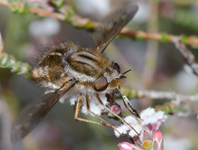Abstract
A new species, Metatarsonemus caissara Lofego & Cavalcante sp. nov., is described based on females and males collected on Eugenia umbelliflora O. Berg. (Myrtaceae) from Atlantic Forest areas of São Paulo State, Brazil. Metatarsonemus Attiah is reinstated as a genus based on apomorphic attributes which are recovered through examination of specimens of the new species herein described, in addition to specimens of M. simplicissimus Attiah and M. megasolenidii Lofego & Ochoa. A cladistic analysis tentatively indicates that the Metatarsonemus lineage is sister group to a lineage comprising the genera complex Daidalotarsonemus+Ceratotarsonemus+Excelsotarsonemus in sharing four homoplasious apomorphic attributes. A dichotomous key is provided for identification of the species of this genus described so far.
References
Attiah, H.H. (1970) New tarsonemid mites associated with citrus in Florida (Acarina: Tarsonemidae). The Florida Entomologist, 53, 179–201.
https://doi.org/10.2307/3493188
Banks, N. (1904) Four new species of injurious mites. Journal New York Entomological Society, 12, 53–56.
Beer, R.E. (1954) A revision of the Tarsonemidae of the Western Hemisphere (Order Acarina). Kansas University Science Bulletin, 36, 1091–1387.
Beer, R.E. & Nucifera, A. (1965) Revisione dei generi della famiglia Tarsonemidae (Acarina). Bollettino di Zoologia agrária e di Bachicoltura, 7, 19–43.
Bremer, K. (1988) The limits of amino acid sequence data in angiosperm phylogenetic construction. Evolution, 42, 795–803.
https://doi.org/10.1111/j.1558-5646.1988.tb02497.x
Canestrini, G. & Fanzago, F (1876) Nuovi Acari italiani (1th serie). Atti della Societa Veneto-Trentina di Scienze Naturali, 5, 99–111.
Canestrini, G & Fanzago, F. (1877) Intorno agli Acari italiani. Atti del Reale Istituto Veneto di Scienze, Lettere ed Arti, Series 5, 4, 69–208.
De Leon, D. (1956) Some mites from Lychee: Descriptions of two new genera and five new species of Tarsonemidae. The Florida Entomologist, 39, 163–174.
https://doi.org/10.2307/3492593
Fain, A. (1970) Coreitarsonemus un nouveau genre d’Acariens parasitant la glande odoriférante des Hémiteres Coreidae (Tarsonemidae: Trombidiformes). Revue de Zoologie et de Botanique Africaines, 82, 315–334.
Fain, A. (1971) Note sur la répartition géographique des Coreitarsoneminae parasites des Hemiptéres Coreides avec description de taxa nouveaux. Bulletin et Annales.de la Societe Royale d’Entomologie de Belgique, 107, 81–88.
Goloboff, P.A. & Catalano, S.A. (2016) TNT version 1.5, including a full implementation of phylogenetic morphometrics. Cladistics, 32, 221–238.
https://doi.org/10.1111/cla.12160
Kaliszewski, M. (1984) Neotarsonemoides adae n. sp., n. gen., (Acari: Tarsonemidae) from Poland. Entomologische Mitteilungen, Zoologischen Museum Hamburg, 8, 1–6.
Lin, J. & Zhang, Z.Q. (2002) Tarsonemidae of the world: Key to genera, geographical distribution, systematic catalogue & annotated bibliography. Systematic and Applied Acarology Society, London, 440 pp.
Lindquist, E.E. (1969) New species of Tarsonemus (Acarina: Tarsonemidae) associated with bark beetles. The Canadian Entomologist, 101, 1291–1314.
https://doi.org/10.4039/Ent1011291-12
Lindquist, E.E. (1985) Description of the adult female of the type-species of Metatarsonemus Attiah, with notes on the synonymy of this genus under Tarsonemus Can. and Fanz. (Acari: Tarsonemidae). The Canadian Entomologist, 117, 1279–1285.
https://doi.org/10.4039/Ent1171279-11
Lindquist, E.E. (1986) The world genera of Tarsonemidae (Acari: Heterostigmata): a morphological, phylogenetic, and systematic revision, with a reclassification of family-group taxa in the Heterostigmata. Memoirs of the Entomological Society of Canada, 136, 1–517.
https://doi.org/10.4039/entm118136fv
Lofego, A.C., Ochoa, R. & de Moraes, G.J. (2005) Some tarsonemid mites (Acari: Tarsonemidae) from Brazilian “Cerrado” vegetation with description of three new species. Zootaxa, 823 (1), 1–27.
https://doi.org/10.11646/zootaxa.823.1.1
Lofego, A.C., Moraes. G.J. & de, Ochoa, R. (2007) Four new species of Xenotarsonemus (Acari: Tarsonemidae) from Brazil. Zootaxa, 1646 (1), 1–15.
https://doi.org/10.11646/zootaxa.1646.1.1
Maddison, W.P. & Maddison, D.R. (2018) Mesquite: a modular system for evolutionary analysis. Version 3.51. Available from: http://www.mesquiteproject.org (accessed 16 May 2019)
Mahunka, S (1973) Auf insekten lebende milben (Acari: Acarida, Tarsonemida) aus Afrika. I. Acta Zoologica Academiae Scientiarum Hungaricae, 19, 75–123.
Magowski, W.L. (2010) Schaarschmidtia, a new subgenus of the genus Tarsonemus Canestrini & Fanzago, 1876 (Acari: Heterostigmatina: Tarsonemidae)—a systematic review of the mite taxon associated with subcortical coleopteran insects, with notes on its host affiliation, ecology and biogeography. Polish Journal of Entomology, 79 (Supplement), 1–76.
Magowski, W.L., Di Palma, A. & Khaustov, A.A. (1998) Ununguitarsonemus rarus (Acari Tarsonemidae) a new species of mite associated with bark beetle from Crimea, Ukraine. Entomologica, Bari, 32, 139–151.
Magowski, W.L., Lindquist, E.E. & Moser, J.C. (2005) Giselia arizonica, a new genus and species of mite (Acari: Tarsonemidae) associated with bark beetles of the genus Pseudopityphthorus (Coleoptera: Scolytidae) in North America. The Canadian Entomologist, 137, 648–656.
https://doi.org/10.4039/n05-035

